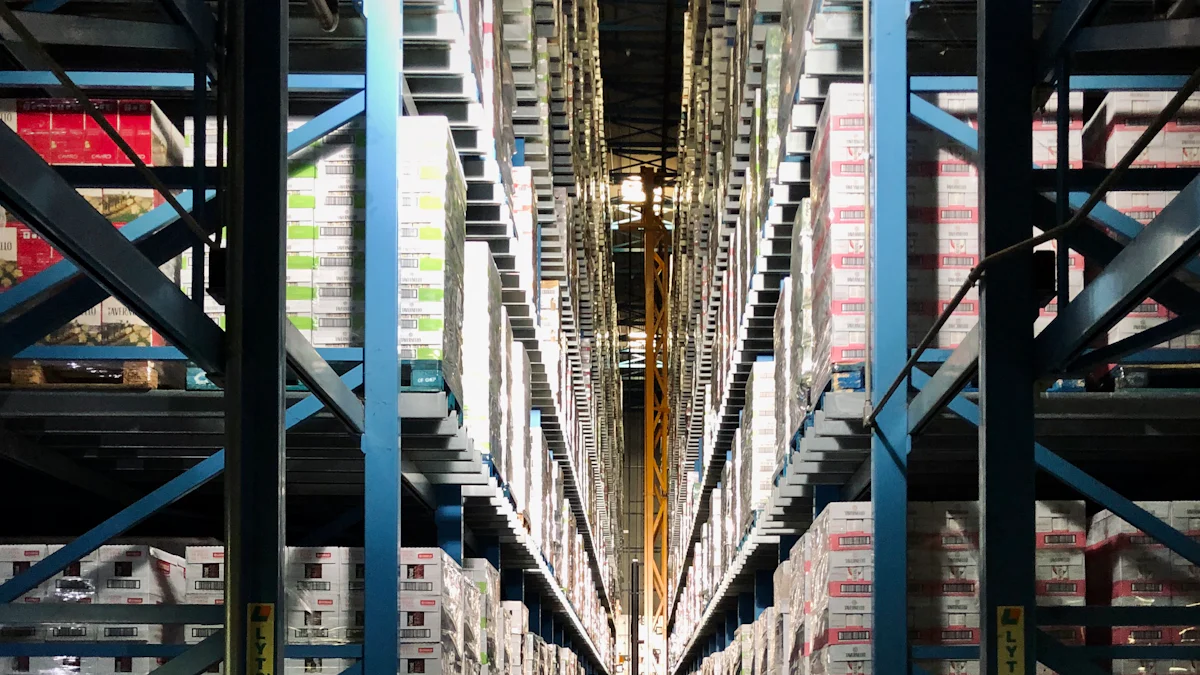Efficient inventory management strategies in overseas warehousing

Inventory management plays a crucial role in global trade. Efficient practices can reduce inventory levels by 20-30%. Accurate demand forecasting can further decrease levels by up to 50%. Overseas warehousing presents challenges like cultural differences and logistical complexities. Effective management minimizes stockouts by 25-30% and prevents obsolete stock. Strategies such as automation and data analytics enhance efficiency. Companies must adopt these methods to thrive in international markets.
Understanding Overseas Warehousing
Definition and Importance
Role in Global Supply Chain
Overseas warehousing serves as a pivotal element in the global supply chain. Warehouses located in strategic international locations facilitate faster delivery times. Businesses can store products closer to their customer base. This proximity reduces shipping costs and improves customer satisfaction. Companies gain a competitive edge by ensuring timely product availability.
Benefits of Overseas Warehousing
Overseas warehousing offers several advantages. Businesses can reduce lead times significantly. Shorter lead times enhance market responsiveness. Companies can also manage inventory levels more effectively. Efficient inventory management minimizes stockouts and overstock situations. Businesses can capitalize on local market opportunities with ease.
Common Challenges
Cultural and Regulatory Differences
Cultural differences present unique challenges in overseas warehousing. Different countries have distinct business practices. Companies must adapt to local customs and traditions. Regulatory differences also impact warehousing operations. Compliance with local laws is crucial for smooth operations. Businesses must navigate these complexities to succeed internationally.
Logistics and Transportation Issues
Logistics and transportation issues often complicate overseas warehousing. International shipping involves multiple modes of transport. Each mode presents its own set of challenges. Delays can occur due to customs clearance processes. Weather conditions may also disrupt transportation schedules. Efficient logistics planning is essential to mitigate these risks.
Case Studies:
Successful Warehousing Practices: A leading electronics company optimized its supply chain by establishing warehouses in key international markets. The company reduced delivery times by 40% and improved customer satisfaction ratings.
Adaptation to Local Regulations: A global retail brand successfully navigated regulatory challenges by partnering with local experts. The brand ensured compliance and maintained smooth operations across various regions.
Strategies for Efficient Inventory Management

Technology Integration in Inventory Management
Use of Inventory Management Software
Inventory management software plays a crucial role in optimizing stock control. Businesses use software to track inventory levels accurately. The software provides real-time data on stock availability. This feature helps prevent overstocking and understocking. Companies can reduce costs by avoiding excess storage fees. Accurate data enhances decision-making processes.
Automation and Robotics
Automation and robotics transform inventory management practices. Machines perform repetitive tasks with precision. Businesses save time and reduce human error through automation. Robots handle tasks like sorting and picking items. These technologies increase efficiency in warehouse operations. Companies experience improved productivity and profitability.
Expert Testimony: "One of the main benefits of using technology in inventory management is the ability to reduce costs and increase profitability. By automating and optimizing inventory processes, businesses can save time and effort, as well as reduce the risks of errors and omissions."
Demand Forecasting
Analyzing Market Trends
Analyzing market trends is essential for effective inventory management. Businesses study consumer behavior to predict demand patterns. Market analysis helps companies adjust stock levels accordingly. Understanding trends allows businesses to meet customer needs promptly. Companies avoid stockouts and lost sales opportunities.
Implementing Predictive Analytics
Predictive analytics enhances demand forecasting accuracy. Businesses use data-driven insights to anticipate future demand. Analytics tools process historical sales data for better predictions. Companies optimize inventory levels based on these forecasts. Predictive analytics minimizes risks associated with supply chain disruptions.
Expert Testimony: "Technologies in inventory management help get a competitive advantage by optimizing the use of resources, increasing customer satisfaction, conducting detailed analysis, and minimizing losses."
Supplier Relationship Management
Building Strong Partnerships
Strong partnerships with suppliers improve inventory management. Businesses collaborate closely with suppliers for timely deliveries. Effective communication ensures smooth supply chain operations. Companies build trust by maintaining transparent relationships. Strong partnerships lead to better negotiation outcomes.
Negotiating Favorable Terms
Negotiating favorable terms with suppliers benefits inventory management. Businesses secure better pricing and payment conditions. Favorable terms reduce overall procurement costs. Companies achieve cost savings through strategic negotiations. Effective negotiation strengthens supplier relationships.
JUSDA's Approach to Inventory Management
JUSDA's Cloud Warehouse Service
Unified Inventory Management
JUSDA employs a unified inventory management system to streamline operations. The system integrates Vendor Managed Inventory (VMI) and Customer Managed Inventory (CMI). This integration allows seamless coordination between suppliers and customers. Businesses experience reduced lead times and improved stock accuracy. JUSDA's approach ensures optimal inventory levels and enhances customer satisfaction.
Advanced Warehouse Planning
JUSDA implements advanced warehouse planning techniques to maximize efficiency. The company uses space optimization strategies to utilize available resources effectively. This meticulous planning reduces operational expenses significantly. Businesses benefit from enhanced productivity and minimized waste. JUSDA's focus on precision leads to superior inventory management outcomes.
Real-Time Monitoring and Risk Prevention
JusLink Platform Capabilities
The JusLink platform offers real-time monitoring capabilities for inventory management. Businesses gain full visibility into their supply chain operations. This transparency helps identify potential risks and prevent disruptions. JusLink provides data-driven insights for informed decision-making. Companies achieve better control over their inventory processes with this platform.
Data-Driven Decision Making
JUSDA leverages data-driven decision-making to enhance inventory management. The company utilizes big data analytics to analyze market trends and demand patterns. This analysis enables accurate forecasting and efficient stock management. Businesses can optimize inventory levels based on these insights. JUSDA's approach minimizes risks and boosts overall supply chain efficiency.

JUSDA Solutions
To provide you with professional solutions and quotations.
Best Practices for Implementation
Regular Audits and Reviews
Regular audits play a vital role in inventory management. Audits help identify discrepancies in stock levels. Businesses can detect errors early through regular checks. Early detection prevents costly mistakes. Audits ensure accuracy in inventory records. Accurate records lead to better decision-making.
Techniques for effective reviews include using technology. Inventory management software streamlines the audit process. Software provides real-time data on stock levels. Real-time data enhances the accuracy of audits. Businesses should schedule audits frequently. Frequent audits maintain inventory accuracy.
Training and Development
Staff training programs are essential for efficient inventory management. Training equips employees with necessary skills. Skilled staff handle inventory tasks more effectively. Effective handling reduces errors in stock management. Businesses should invest in comprehensive training programs.
Continuous improvement initiatives foster a culture of learning. Employees stay updated with industry trends. Staying updated helps adapt to changing market demands. Adaptation ensures businesses remain competitive. Continuous improvement leads to better inventory management outcomes.
Survey Results:
Key Findings: Regular audits, technology use, and staff training are crucial for successful inventory management.
Significant Trends: Businesses that prioritize audits and training see improved inventory accuracy.
Efficient inventory management in overseas warehousing requires key strategies. Technology integration, demand forecasting, and supplier relationship management are essential. Adapting to changing environments ensures success. Businesses must embrace new technologies and practices. Continuous improvement leads to competitive advantages. Implementing these strategies enhances inventory accuracy and reduces costs. Businesses achieve better customer satisfaction and operational efficiency.
See Also
Enhancing Warehouse Efficiency with Robotic Automation Technology
Boosting Warehouse Productivity through Logistics Robotics
Maximizing Business Potential with Advanced Inventory Strategies
Addressing Global Supply Chain Expansion Challenges Effectively
Revealing JUSDA's Latest Warehousing Facilities for Enhanced Efficiency
